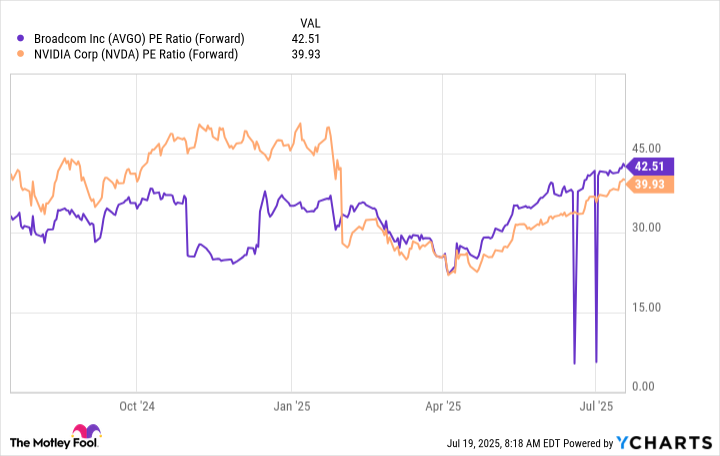Stock splits were a big thing last year, with many major companies across industries launching such operations. Two of the most exciting were in the area of artificial intelligence (AI). Nvidia (NVDA +3.80%), the world's No. 1 AI chip designer, and Broadcom (AVGO +3.18%), a networking giant, completed stock splits in June and July 2024, respectively.
What is a stock split, and why do companies go this route? These operations enable a company to bring down a soaring stock price to more reasonable levels, making the stock more accessible to a broader range of investors. Nvidia and Broadcom even said they decided on splits to make it easier for employees and investors to get in on their shares, which had surged more than 200% and about 100%, respectively, in 2023.
Stock splits don't change the total market value of the company or anything fundamental, though. They simply involve offering more shares to current holders according to the ratio of the split. So, for example, in a 10-for-1 stock split, if you originally held one share, you would hold 10 shares post-split -- but the total value of your holding would remain the same.
Because of this, a stock split alone isn't a reason to buy or sell a stock. Still, it's interesting to see how stock split players have performed a year after these operations, so let's take a look at both Nvidia and Broadcom a year after their splits.

Image source: Getty Images.
Nvidia
Nvidia completed its 10-for-1 stock split on June 7 of last year, with shares trading at the split-adjusted price as of June 10. This brought the shares down from about $1,200 to $120. Since that time, Nvidia stock has experienced ups and downs, but it's delivered a gain of more than 40%.
As mentioned, this operation isn't the reason investors have flocked to Nvidia over the past year (though a lower price per share may have made it easier for some to get in on the growth story). What has driven Nvidia's share price performance is the ongoing high demand for its graphics processing units (GPUs), or AI chips, and related products and services.

NASDAQ: NVDA
Key Data Points
What also helped this AI leader was its strong execution of a big launch: Nvidia released its Blackwell architecture and chip this past winter to demand that CEO Jensen Huang called "insane." The company generated $11 billion in revenue from Blackwell in its very first quarter of commercialization and maintained a gross margin above 70%, ensuring high profitability on sales.
Although investors worried about potential headwinds, such as import tariffs or a decrease in AI spending, these concerns have eased. Trade talks have spurred optimism that tariffs may not be as hefty as initially expected, and companies have reiterated their AI investment plans. All of this helped boost Nvidia's shares in recent weeks, even pushing the company to a $4 trillion market cap, making it the first company ever to reach this level.
Broadcom
Broadcom executed its stock split on July 12, and the stock began trading on July 15 at the new price. Like Nvidia, the company decided on a 10-for-1 split to bring its share price down -- in this case, from about $1,700 to $170. Broadcom stock has also climbed in the double digits since the operation, rising more than 65%.

NASDAQ: AVGO
Key Data Points
And like Nvidia, Broadcom saw its shares take off thanks to demand from AI customers. This company is a networking leader, making thousands of products used in a variety of locations -- from your smartphone to major data centers. But in recent times, demand from big cloud service providers to support their AI development has helped revenue skyrocket.
In the most recent quarter, AI revenue surged 77% to $4.1 billion, and the company says it expects this momentum to continue in the current quarter and through the next fiscal year. This is amid demand for both connectivity products and Broadcom's accelerated processing units (XPUs), a type of processor for specific AI tasks.
The company says its networking expertise and wide range of products -- from switches and routers to network interface cards (NICs), which connect computers to networks -- have been key growth drivers as cloud service providers ramp up their AI platforms.
Broadcom stock followed a similar path to Nvidia, declining in April of this year due to general tariff concerns, but it has also rebounded and is on the rise today. The stock even closed at a record high just a few days ago.
Could the post-split success continue?
Both Nvidia and Broadcom have completed successful post-split years, scoring double-digit gains. Nvidia is slightly less expensive from a valuation standpoint than it was a year ago, but Broadcom's valuation has advanced.
AVGO PE Ratio (Forward) data by YCharts. PE Ratio = price-to-earnings ratio.
Still, these AI players remain reasonably priced, considering their earnings track record and long-term prospects in this growth market. It's impossible, of course, to guarantee what these stocks will do next, but the current environment supports the idea of more gains ahead. Even more importantly, Nvidia and Broadcom are well positioned to win in the AI market over the long run.






